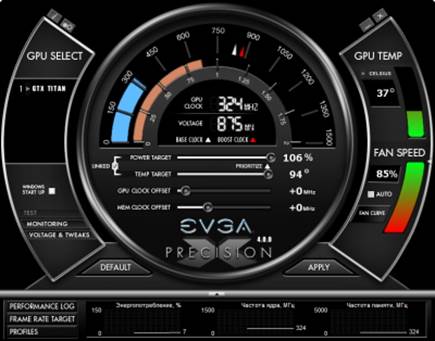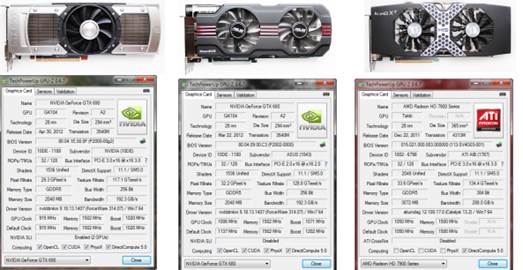Overclocking
We check out the overclocking capabilities
of the GeForce GTX Titan using EVGA Precision X utility in maximum power level
and temperature:

The
EVGA Precision X
To ensure the cooling process, we remove
the front panel of the PC case and leave the fans of the Titan running with its
maximum speed of 4,000 RPM.
After many hours of the testing process, we
try to increase the clock speed of the GPU to about 135 MHz and the memory
frequency ranges T 1,300 MHz.
The clock speed obtained 927/1011/7308 MHz.

The
overclocking result
However, we had to gradually reduce the graphics
memory frequency to about 40 MHz (also 7,268 MHz) to prolong the testing
process. The frequency of the GPU was overclocked card can sometimes reach 1,137
MHz, but always fell to 1,071 MHz to transmit data at a high level.

Overclocking
results graphically
As you can see, the GPU works very
comfortably with the GK 110 placed under our conditions, its temperature does
not exceed 640C. Our efforts to overclock it at 1,187 volts voltage
were unsuccessful, so we stopped at the clock speeds as mentioned above.
Power consumption
We measure the energy consumption during
our test equipment with different graphics cards using the multifunctional Zalman
ZM-MFC3, which can report the power consumption of a computer (without
monitor). There are two test modes: 2D (text editing in Microsoft Word or web
surfing) and 3D (4 attempts in the opening scene Crysis 3 with 2560x1440
resolution is to install the highest quality image, but no MSAA). Our test
indicates that the new game has greater opening magnitude than the previous
times using Metro 2033: The Last Refuge, which is why we chose to replace it.
For the purposes of this comparison we
added the results of the Nvidia GeForce GTX 690, ASUS GeForce GTX 680 DirectCU
II TOP and HIS 7970 X2 ICEQ GHz Edition 3 GB. Let's see if we get something:

Energy
consumption results
When the GeForce GTX Titan operates at
clock speeds of its default, the system needs more than 55 to 60 watts compared
to the ASUS GeForce GTX 680 and 44 to 45 watts compared to the HIS Radeon HD
7970. When the Titan is overclocked, the power consumption increased from 25 to
547 watts, not much for a configuration with a high-end graphics card. In fact,
the results for the system processor of the Nvidia GeForce GTX 690 sometimes are
just less than 50 watts. So there is nothing surprising here.
The configuration of all the graphics is
comparable with each other, considering the low idle mode energy consumption of
them is.
Configure and test methods
All graphics cards involved will be tested
in a standard system with the following configurations:
·
Motherboard: Intel Siler DX79SI (Intel X79
Express, LGA 2011, BIOS 0494)
·
CPU: Intel Core i7-3960X Extreme Edition 3.3
GHz, 1.2 V, 6 x 256 KB L2, 15 MB L3 (Sandy Bridge-E, C1, 32nm)
·
CPU Cooling Fan: Phanteks PH-TC 14PE (2 x 135 mm
fans at 900 RPM)
·
The surface cooling: ARCTIC MX-4
·
Graphics card: Nvidia GeForce GTX 690 2 x 2 GB,
ASUS GeForce GTX 680 DirectCU II TOP 2 GB, HIS 7970 X2 ICEQ GHz Edition 3 GB
·
System Memory: 4 x 4GB DDR3 Mushkin Redline
(Spec: 2133 MHz / 9-11-10-28 / 1.65 V)
·
System Hard Disk: Crucial m4 256 GB SSD
(SATA-III, CT256M4SSD2, BIOS v0009)
·
Drive: for programs and games: Western Digital
VelociRaptor (300GB, SATA-II, 10,000 RPM, 16MB cache, NCQ) inside Scythe Quiet
Drive 3.5 "HDD silencer and cooler
·
Backup Drive: Samsung EcoGreen F4 HD204UI (SATA-II,
2 TB, 5,400 RPM, 32 MB, NCQ)
·
Chassis: Antec Twelve Hundred (front panel,
three Noiseblocker NB-multiframe S-Series MF12-S2 fans at 1,020 RPM, back
panel: two-BlackSilenPRO Noiseeblocker NB PL-1 fans at 1,020 RPM, top panel: standard
200 mm fan at 400 RPM)
·
Operating and control panel: Zalman ZM-MFC3
·
Source: Seasonic SS-1000XP Active PFC F3 1,000W
(with a default 120 mm fan)
·
Display: 27 "Samsung S27A850D (DVI-I, 2560
× 1440, 60Hz)
Among all the
graphics cards mentioned above, only Asus has higher nominal frequency at all,
which is why we decided to adjust them with the original GeForce GTX 680 in
order that our testing process is accurate:

The
testing process
To reduce the dependence of the performance
of the graphics card on its foundation speed, I overclocked the CPU with 6 cores
of 32 nm with the 37x multiplier, BCLK frequency set at 125 MHz and "Load-Line
Calibration" enabled at 4.625 GHz. The Vcore processor was increased to 1:49
V in the BIOS of the motherboard:

Overclocking
the CPU
The Hyper-Threading Technology is allowed.
The 16 GB DDR3 system memory operates with 2 GHz frequency parameters, which
are 9-11-10-28 timings and the voltage is 1.65 V.
The trial began on February 24, 2013. All the
tests were done based on the Microsoft Windows 7 Ultimate x64 SP1 operating
system with all updates and driver parameters up to date as follows:
·
Intel Chipset Drivers 9.4.0.1014 WHQL from
07.02.2013 for the motherboard chipset;
·
DirectX End-User Runtimes libraries
·
AMD Catalyst 13.2 Beta 5 (12.100.17.0) + driver
from Catalyst Application Profiles 05/02/2013 12:11 (Fiber2) for the graphic
card of AMD platforms
·
Nvidia GeForce 314.09 WHQL driver for GeForce
GTX TITAN from 21.02.2013 and from 02.18.2013 GeForce 314.07 WHQL for GeForce
GTX 690 and GTX 680
We conducted two
tests with the following resolutions: 1920x1080 and 2560x1140. The test was
conducted with two different image modes: "Quality + AF16x", the
default image quality with the driver that allows the image filter cut-aliasing
of 16, and "Quality+AF16x+MSAA 4 (8)x", that allows the image filter
cut-aliasing process of 16x and full screen of 4x and 8x if the average frame
rate is enough to experience the game in a relaxed manner. We also allow the
filter and aliasing filter cutoff of the image while installing the game. If
this requirement is not fully equivalent, we change them in Control Panels, the
Catalyst drivers and GeForce. Here, we also disable Vsync. There was no other
change in the driver installation item.